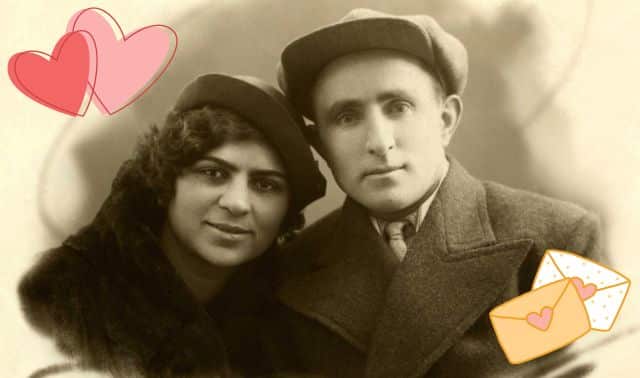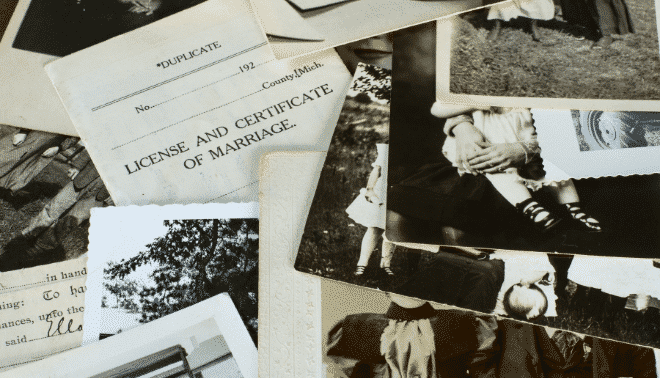Sign up for the Family Tree Newsletter! Plus, you’ll receive our 10 Essential Genealogy Research Forms PDF as a special thank you.
Get Your Free Genealogy Forms
"*" indicates required fields
Winter is nearly over! Take advantage of your last few weeks confined indoors by studying your family’s history. These five genealogy tasks for February will keep you cozy while moving your research forward.
1. Focus on Marriage Records
With Valentine’s Day in mind, make sure you’ve fully documented all the marriages in your family tree. Marriage certificates often contain information about both the bride and groom and previous generations: names of parents, ancestral birthplaces and (especially) maiden names.
Fortunately, laws for accessing recent marriage records are generally laxer than they are for birth and death records. Non-direct descendants might only have to wait 50 years from the date of a marriage to request records, whereas the restriction may be longer (75 or even 100 years) for birth and death certificates. Marriage records were also generally kept earlier than other vital events, helpful when you’re researching in a place with relatively late vital-registration mandates.
Don’t think only about marriage certificates and licenses, however. Weddings generated a variety of documents: marriage banns (published in newspapers or by the sponsoring church ahead of the ceremony) or bonds (paid by the groom or his family), for example. Take some time to learn about marriage customs in your ancestor’s time, place and culture to see what may be available.
Also look for mementos kept at home, such as:
- Newspaper announcements
- Photo albums
- Wedding attire, especially dresses and bouquets
- Gifts that include the wedding date or name of bride and groom
You likely have an ancestor who married multiple times. Play around with your preferred genealogy software or online family tree to learn how to document blended families and second (or third, or fourth) marriages.
2. Revisit Family Groups
Though not fully inclusive, the “nuclear family” (a married couple and their children) forms the basic unit of most genealogical research. Indeed, many researchers organize their research by family group, creating a folder or binder for each couple.
Revisit the families that you’ve documented. Have you made a family group sheet for each married couple in your tree? For each family, you should have:
- A marriage certificate for the couple, plus a divorce certificate (if applicable)
- Birth certificates for each child, plus death certificates (especially if they died young)
- Notes about where the family lived over time, including addresses and (if possible) photos of their home(s)
- References to each census you’ve found the family in
Take special care to document even those family members that you’re not descended from. Those collateral relatives can help you solve family mysteries involving your direct-line ancestors.
3. Tap into Local Libraries
February is Library Lover’s Month, but you can enjoy the benefits of libraries in your and your ancestors’ communities all year long! USA.gov has a library finder to help you find institutions, especially those in places you don’t live. And WorldCat is a central database for the holdings of libraries around the world.
Visit a library’s website to see what resources it has. Many have published genealogy guides that highlight materials of interest to family historians, both physical (print books and manuscripts, city directories, microfilm collections) and digital (record images, searchable indexes). You might need to be a resident to access digital collections from home. But you should be able to view physical items in the library itself—just be sure to confirm if you’ll need an appointment).
Libraries also often make databases available to their patrons. These range from academic collections like ProQuest to institutional versions of sites like Ancestry.com.
Don’t forget about FamilySearch Centers! These branches of the FamilySearch Library in Salt Lake City often have their own local record collections, the product of decades of FamilySearch’s records-preservation efforts. You can no longer borrow microfilm between FamilySearch Centers. But you can view microfilm at the center where it’s housed, and (from computers there) access any collections that are only available at FamilySearch Centers because of licensing agreements.
4. Publish Your Tree in a New Place
We all have our preferred family tree-builders, and you may have even spent considerable time deciding which website or desktop software is best for you. But consider adding at least some of your family tree to a new website: uploading to Ancestry.com if you’re a regular MyHeritage user, for example. Rick Crume rounds up 18 popular options here, and compares their various features and target audiences.
Family trees make useful “cousin bait,” potentially attracting relatives you haven’t previously contacted. And having a tree at another service will allow you to receive that site’s record hints, which provide a potential shortcut to relevant documents.
GEDCOMs (the file format for family trees) make it somewhat easy to transfer your trees between providers. Note that GEDCOMs don’t include media files such as photos or (generally) record images, though, so you’ll need to do some manual work reattaching those elements.
5. Find Personal Correspodence
Did your ancestors send love letters, or keep journals? These personal touches add a whole new dimension to your research and flesh out your relatives as people with complex personalities, dreams and foibles. Personal correspondence can also make compelling written narratives for sharing with relatives or publishing as a book or blog.
Crawl through the materials you’ve curated over the years for such materials. Remember that other branches of your family tree may have inherited them from your ancestors, so identify any cousins who might be willing to share these treasures with you.
If you can’t find letters or diaries from your own ancestors, consider reading those written by others from the same time and place. They’re sometimes collected and published by libraries (see No. 4) and archives, and might be representative of your ancestor’s life experience. They’re also often entertaining in and of themselves; here‘s a collection of historical swoon-worthy love letters.
Related Reads
Last updated: January 2025










